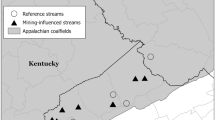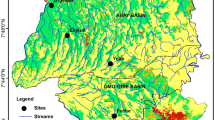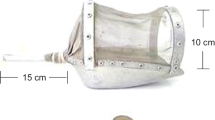Abstract
Stream biological monitoring programs using benthic invertebrates have been implemented in all States and Territories of Australia in recent years. Although some variations exist in sorting strategies, all have adopted a rapid bioassessment approach with the collection of a single large sample from specified habitats at a site. However, the adequacy of the size of the sample collected has never been assessed. In this study, we examined data collected from rivers in three different States (Victoria, Queensland and Western Australia – each from a distinct bioregion of Australia), from four habitats (riffles, edges, macrophytes and pool rocks) and collected over four sample sizes (smaller and larger than that the national standard of 10 m or 10–20 pool rocks). We also used a subset of the data to examine the interaction of taxonomic resolution (family vs species) with sample size. All samples were collected using a live sorting approach which aimed at maximizing taxa richness while collecting about 200 animals.
We found that the current recommended sample size adequately described the invertebrate community at a site in comparison to samples of other sizes. There were some differences between the States and these varied with habitat. In some instances, smaller sized samples would be adequate for monitoring purposes. Taxonomic level had little effect with only the riffle species samples showing a significant difference between sizes in contrast to the family level data which showed no difference.
Similar content being viewed by others
References
Barbour, M. T. & J. Gerritsen 1996. Subsampling of benthic samples: a defense of the fixed-count method. J. n. amer. Benthol. Soc. 15(3): 386–391.
Barmuta L. A., 1989. Habitat patchiness and macrobenthic community structure in an upland stream in temperate Victoria, Australia. Freshwat. Biol. 21: 223–236
Boulton, A. J. & L. N. Lloyd, 1991. Macroinvertebrate assemblages in floodplain habitats of the lower River Murray, South Australia. Regulated River: Research and Management 6: 183–201.
Bunn, S. E., 1986. Spatial and temporal variation in the macroinvertebrate fauna of streams of the northern jarrah forest, Western Australia: functional organisation. Freshwat. Biol. 16: 621–632.
Bunn, S. E. & P. M. Davies, 1990. Why is the stream fauna of south-western Australia so impoverished? Hydrobiologia 194: 169–176.
Bunn, S. E. & P. M. Davies, 1992. Community structure of the macroinvertebrate fauna and water quality of a saline river system in south-western Australia. Hydrobiologia 248: 143–160.
Belbin, L., 1993. ‘PATN Pattern Analysis Package’. Technical Reference. CSIRO Division of Wildlife and Ecology, Canberra.
Cao, Y., W. P. Williams & A. W. Bark, 1997. Effects of sample size (replicate number) on similarity measures in river benthic Aufwuchs community analysis. Wat. Environ. Res. 69: 107–114.
Carpenter, S. R. & D. M. Lodge, 1986. Effects of submersed macrophytes on ecosytem processes. Aquat. Bot. 26: 341–370.
Chessman, B. C., 1995. Rapid assessment of rivers using macroinvertebrates: a proceedure based on habitat-specific sampling, family-level identification and a biotic index. Aust. J. Ecol. 18:117–143.
Chutter, F. M., 1998. Research on the Rapid Biological Assessment of Water Quality Impacts in Streams and Rivers. Report to the Water Research Commission. WRC Report No. 422/1/98.
Davies, P. E., 1994. ‘National River Processes and Management Program Monitoring River Health Initiative. River Bioassessment Manual Version 1.0’. Department of the Environment, Sport and Territories, Canberra.
Downes B. J., P. S. Lake & E. S. G. Schreiber, 1993. Spatial variation in the distribution of stream invertebrates: implications of patchiness for models of community organization. Freshwat. Biol. 30: 119–132.
Eaton L. E. & D. R. Lenat, 1991. Comparison of a rapid bioassessment method with North Carolina's qualitative macorinvertebrate collection method. J. n. am. Benthol. Soc. 10(3): 335–338.
Furse, M. T., D. Moss, J. F. Wright & P. D. Armitage, 1984. The in-fluence of seasonal and taxonomic factors on the ordination and classification of running-water sites in Great Britain and on the prediciton of their macro-invertebrate communities. Freshwat. Biol. 14: 257–280.
Growns J. E., B. C. Chessman, P. K. McEvoy & I. Wright, 1995. Rapid assessment of rivers using macroinvertebrates: Case studies in the Nepean River and Blue Mountains, NSW. Aust. J. Ecol. 20(1): 130–141.
Hannaford, M. J. & V. H. Resh, 1995. Variability of macroinvertebrate rapid-bioassessment surveys and habitat assessments in a northern California stream. J. n. amer. Benthol. Soc., 14:430–439.
Humphries, P., P. E. Davies & M. Mulcahy, 1996. Macroinvertebrate assemblages of littoral habitats in the Macquarie and Mersey Rivers, Tasmania: Implications for the management of regulated rivers. Regul. Riv.: Res. Manage. 12: 99–122.
Lake, P. S., L. A. Barmuta, A. J. Boulton, I. C. Campbell & R. M. St Clair, 1986. Australian streams and Northern Hemisphere ecology: comparisons and problems. Proc. Ecol. Soc. Aust. 14:61–82.
Lenat D. R., 1988. Water quality assessment of streams using a qualitative collection method for benthic macroinvertebrates. J. n. amer. Benthol. Soc. 7, 222–233.
Lenat, D. R. & M. T. Barbour, 1993. Using benthic macroinvertebrate community structure for rapid, cost-effective, water quality monitoring: rapid bioassessment. In Loeb S. L. & A. Spacie (eds), Biological Monitoring of Aquatic Systems, CRC Press, London.
Mackey A. P., D. A. Cooling & A. D. Berrie, 1984. An evaluation of sampling strategies for qualitative surveys of macro-invertebrates in rivers, using pond nets. J. Appl. Ecol. 21: 515–534.
Marchant, R., 1990. Robustness of classification and ordination techniques applied to macroinvertebrate communities from the La Trobe River, Victoria. Aust. J. mar. Freshwat. Res. 41:493–504.
Marchant, R., L. A. Barmuta & B. C. Chessman, 1995. Preliminary study of the ordination of macroinvertebrate communities from running waters in Victoria, Australia. Aust. J. Mar. Freshwat. Res. 45: 945–962.
Marchant, R., A. Hirst, R. Norris, R. Butcher, L. Metzeling & D. Tiller, 1997. Classification and prediction of macroinvertebrate assemblages from running waters in Victoria, Australia. J. n. amer. Benthol. Soc. 16: 664–681.
Marchant, R., A. Hirst, R. Norris & L. Metzeling, 1999. Classification of macroinvertebrate communities across drainage basins in Victoria, Australia: consequences of sampling on a broad spatial scale for predictive modelling. Freshwat. Biol. 41(2): 253–268.
Metzeling, L. H., A. Graesser, P. Suter & R. Marchant, 1984. the distribution of aquatic macroinvertebrates in the upper catchment of the LaTrobe River, Victoria. Occasional Papers of theMuseum of Victoria 1: 1–62.
Norris, R. H. & M. C. Thoms, 1999. What is river health? Freshwat. Biol. 41(2): 197–210.
Palmer, C. G., J. H. O'Keefe & A. R. Palmer, 1991. Are macroinvertebrate assemblages in the Buffalo River, southern Africa, associated with particular biotopes? J. n. amer. Benthol. Soci. 10: 349–357.
Pardo, I. & P. D. Armitage, 1997. Species assemblages as descriptors of mesohabitats. Hydrobiologia 344: 111–128.
Plafkin J. L., M. T. Barbour, K. D. Porter, S. K. Gross & R. M. Hughes, 1989. Rapid Bioassessment protocols for use in streams and rivers: benthic macroinvertebrates and fish. EPA/444/4–89–169001. United States Environmental Protection Agency, Washington, D.C.
Simpson, J., R. H. Norris, L. A. Barmuta & P. Blackman, 1997. ‘Australian River Assessment System. National River Health Program Predictive Model Manual.’ From the web sitehttp://ausrivas.canberra.edu.au/ausrivas/.
Smith, M. J., W. R. Kay, D. H. D. Edward, P. J. Papas, K. Richardson, StJ., J. C. Simpson, A. M. Pinder, D. J. Cale, P. H. Horwitz, J. A. Davis, F. H. Yung, R. H. Norris & S. A. Halse, 1999. AUSRIVAS: using macroinvertebrates to assess ecological condition of rivers in Western Australia. Freshwat. Biol. 41(2): 269–282.
Sneath, P. H. A. & R. R. Sokal, 1973. Numerical Taxonomy. W.H. Freeman, San Fransisco.
Storey, A. W., D. H. D. Edward & P. Gazey, 1991. Surber and kick sampling: a comparison for the assessment of macroinvertebrate community structure in streams of south-western Australia. Hydrobiologia 211: 111–121.
Tiller, D. & L. H. Metzeling, 1998. ‘Rapid Bioassessement of Victorian Streams’. EPA publication 604, Environment Protection Authority, Victoria. ISBN 0 7306 7538 6.
Turak, E., L. K. Flack, R. H. Norris, J. C. Simpson & N. Waddell, 1999. Assessment of river condition at a large spatial scale using predictive models. Freshwat. Biol. 41(2): 283–299.
Wilkinson, L., M. A. Hill, P. Howe & S. Miceli, 1997. SYSTAT for Windows, Version 7, Evanston, IL, SYSTAT Inc.
Wright, I. A., B. C. Chessman, P. G. Fairweather & L. J. Benson, 1995. Measuring the impact of sewage effluent on the macroinvertebrate community of an upland stream: The effect of different levels of taxonomic resolution and quantification. Aust. J. Ecol. 20(1): 142–149.
Wright, J. F., D. Moss, P. D. Armitage M. T. Furse, 1984. A preliminary classification of running-water sites in Great Britian based on macro-invertebrate species and the prediction of community type using environmental data. Freshwat. Biol. 14: 221–256.
Zwick, P., 1992. Stream habitat fragmentation - a threat to biodiversity. Biodiversity and Conservation 1: 80–97.
Author information
Authors and Affiliations
Rights and permissions
About this article
Cite this article
Metzeling, L., Miller, J. Evaluation of the sample size used for the rapid bioassessment of rivers using macroinvertebrates. Hydrobiologia 444, 159–170 (2001). https://doi.org/10.1023/A:1017571200859
Issue Date:
DOI: https://doi.org/10.1023/A:1017571200859




